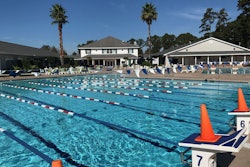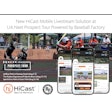Source: National Athletic Trainers' Association
Improvements in Sports Health Policies Encouraged
INDIANAPOLIS, March 22, 2016 – In 2015 alone, 50 high school athletes’ lives were lost during sport or physical activity while thousands of others have long-term complications resulting from athletic injuries. The second annual Collaborative Solutions for Safety in Sport press event, hosted by the National Athletic Trainers’ Association (NATA) and American Medical Society for Sports Medicine (AMSSM), addressed these concerns by sharing best practices and encouraging improvement in safety protocols. Research shows that most of these deaths and injuries can be reduced or prevented if best practices are in place. The event took place at NCAA headquarters.
Sports medicine leaders presented new research, recent successes and challenges pertinent to sports health. A new study, “Implementing Health and Safety Policy Changes at the High School Level from a Leadership Perspective” and an accompanying commentary, “Sport Safety Policy Changes: Saving Lives and Protecting Athletes,” was advanced released this morning and will be published in the April issue of the Journal of Athletic Training, NATA’s scientific publication. To read the study and commentary please visit:
https://natajournals.org/doi/pdf/10.4085/1062-6050-51.2.09 and
https://natajournals.org/doi/pdf/10.4085/1062-6050-51.4.14.
Following the press conference, NATA and AMSSM with the support of Gatorade, Korey Stringer Institute, NCAA, National Federation of State High School Associations and Sanford Health, brought together sports medicine and high school sports representatives in secondary school athletics. For the second year in a row, representatives from all 50 states attended to discuss safety in youth sports during an intensive two-day meeting.
Policies by the numbers (and percent improvements since the 2014-15 school year):*
- Concussions: 44 percent of states require that a graduated return-to-play protocol consisting of at least five steps with no more than two steps occurring on one day is implemented for athletes returning back to activity from a concussion: a 24 percent improvement.
- Heat acclimatization: 48 percent of states meet the recommendation that total practice time should not exceed three hours in any one day: a 20 percent improvement. And, 62 percent of states meet the recommendation that all schools have a heat modification policy: a 20 percent improvement.
- Emergency action plans: 28 percent of states meet the recommendation that every school or organization that sponsors athletics develop an EAP for managing serious or potentially life-threatening injuries: a 6 percent improvement.
*Recommendations are based on current, evidence-based best practices.
“The National Athletic Trainers’ Association has had a longstanding commitment to the health and welfare of student athletes,” says Scott Sailor, EdD, ATC, NATA president. “We remain steadfast in our support of safety
protocols along with AMSSM, and collectively encourage the establishment of best practices and the appropriate sports medicine professionals on the field for both games and practices to ensure the gold standard of care.” Currently, only 37 percent of high schools across the country have full-time athletic trainers who play a vital role in keeping young athletes safe.”
“The American Medical Society for Sports Medicine is proud to continue its support of this program in conjunction with NATA,” says Jon Divine, MD, MS, AMSSM president. “This forum allows us to share resources, tools, sports safety protocols and strategies designed to keep young athletes thriving on the field and off the sidelines. Their health and welfare is our primary concern.”
Nationally Acclaimed Speakers Address Secondary School Health and Safety Protocols
The press conference included prominent youth sports safety medical experts. Sailor and Divine provided introductory remarks. Douglas Casa, PhD, ATC, FNATA, chief executive officer, Korey Stringer Institute, and director of Athletic Training Education and professor in the Department of Kinesiology at the University of Connecticut, addressed how policy changes save lives. Cindy J. Chang, MD, associate professor, UCSF Sports Medicine, chair, Sports Medicine Advisory Committee, California Interscholastic Federation (CIF), and AMSSM past president, discussed the role of the team physician and the day to day challenges of implementing change.Brian Hainline, MD, chief medical officer, NCAA, talked about the health and welfare of the student athlete from high school to college. William Heinz, MD, chair, Sports Medicine Advisory Committee, National Federation of State High School Associations (NFHS), discussed the NFHS perspective on enhancing policy change. Nick Inzerello, senior director, Football Development, USA Football, discussed Heads Up Football High School: Improved coaching education and medically endorsed standards. Kelly Pagnotta, PhD, ATC, PES, assistant professor of Athletic Training, Temple University, presented her research findings on health and safety policy changes at the high school level from a leadership perspective (April 2016 Journal of Athletic Training study).Denise Alosa, ATC, Sports Medicine Advisory Committee member, Vermont Principals’ Association, addressedgrassroots success and Vermont best practices.
Recommendations for Evidence-Based Best Practices in High School Sports
In an effort to provide coaches, athletic directors, parents, athletes, school administrators and others with health and safety best practices, the sports medicine experts provided the following overriding recommendations:
1. Create an emergency action plan in collaboration with coaches, athletic trainers, other medical professionals and local and campus safety officials.
2. Have athletic trainers on staff: athletic trainers play a critical role in preventing sudden death in sport such as prevention, diagnosis, emergency care and treatment.
3. Acquire and place automated external defibrillators (AEDs) on school campuses and at sporting facilities for immediate access in the case of a cardiac emergency.
4. Ensure that athletes acclimatize progressively to training demands and environmental conditions for optimal safety. Conditioning should be phased in gradually: the first seven to 10 days of any new cycle should be considered transitional. Exercise and conditioning should not be used as punishment.
“Today’s program provides us with new insights on successes and challenges for us to discuss and address when shaping state high school sports safety programs,” said Sailor. “Improving and implementing the right policies and putting them into action will help reduce injury and catastrophic outcomes.”
“Our approach to high school student athlete health and welfare requires a collaborative effort. We are inspired by the outcome of today’s forum and encourage all of those in attendance and those who can influence the lives of young athletes to use this information in the sports seasons ahead. We all individually and as a group have a vital role in ensuring youth sports safety in the year ahead,” added Divine.
Speaker information or interviews are available upon request.
For more information on each of the topics mentioned, please visit: www.SolutionsForAthleteCare.org
About NATA: National Athletic Trainers’ Association (NATA) – Health Care for Life & Sport
Athletic trainers are health care professionals who specialize in the prevention, diagnosis, treatment and rehabilitation of injuries and sport-related illnesses. They prevent and treat chronic musculoskeletal injuries from sports, physical and occupational activity, and provide care for acute injuries. Athletic trainers offer a continuum of care that is unparalleled in health care. The National Athletic Trainers’ Association represents and supports 43,000 members of the athletic training profession. Visit www.nata.org
About AMSSM:
American Medical Society for Sports Medicine (AMSSM) is a multi-disciplinary organization of 3,000 sports medicine physicians dedicated to education, research, advocacy and the care of athletes of all ages. The majority of AMSSM members are primary care physicians with fellowship training and added qualification in sports medicine who then combine their practice of sports medicine with their primary specialty. AMSSM includes members who specialize solely in non-surgical sports medicine and serve as team physicians at the youth level, NCAA, NFL, MLB, NBA, WNBA, MLS and NHL, as well as with Olympic teams. By nature of their training and experience, sports medicine physicians are ideally suited to provide comprehensive medical care for athletes, sports teams or active individuals who are simply looking to maintain a healthy lifestyle. Visit www.amssm.org





























